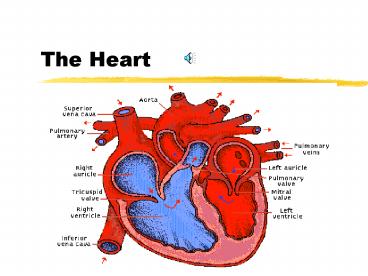The Heart - PowerPoint PPT Presentation
1 / 17
Title:
The Heart
Description:
How the Heart Works. There are two stages in the heart beat cycle. The diastole (relaxation) ... Your heart is also affected by exercise which is another ... – PowerPoint PPT presentation
Number of Views:151
Avg rating:3.0/5.0
Title: The Heart
1
The Heart
2
Structure of the Heart
- Two parallel independent systems
- Two different pumps
- Each _at_ atrium
(auricle) ventricle - Designating right
cavity left cavity - as if you were wearing
- your heart
3
Heart Valve replacement
4
Function of the Cavities
- Right cavity takes in oxygen poor blood from the
body - Pumps it to the lungs
- Left cavity takes oxygen rich blood from the
lungs - Returns it to the body
5
Functions of the Cavities
- Atrium draws blood in
from veins - Ventricle pushes blood
away through arteries
6
Differences Between the Cavities
- Right cavity takes in oxygen poor blood from the
body sends it to the lungs - Left cavity takes oxygen rich blood from the
lungs and sends it to the body through the aorta.
Its wall is thicker because it has to pump the
blood throughout the body
7
How the Heart Works
- There are two stages in the heart beat cycle
- The diastole (relaxation)
- The systole (contraction)
8
Diastole
- In diastole the heart
relaxes and blood
goes into the two
auricles - Rising pressure in
each auricles opens
the tricuspid and
mitral valves and
blood flows into
the ventricles
9
Systole
- Filled ventricles
contract and the mitral
and tricuspid valves
close - The filled ventricles
force the aorta and
pulmonary valves to
open - Blood is then pushed
into the arteries
10
Rate of Heartbeat
- The heart is a muscle is a unique muscle.
- It has the ability to contract spontaneously at a
regular rate of 80 beats per minute - That is what creates the pulse
11
Rate of Heartbeat
- However this rate is influenced by two nervous
systems - Sympathetic
- Parasympathetic
12
Sympathetic
- This controls your heart by fear, and adrenaline.
- For example when you get scared your heart
intends to beat faster. - Your heart is also affected by exercise which is
another aspect of the sympathetic nervous system
13
Parasympathetic
- This nervous system controls your heart rate when
you sleep - Your heartbeat is much slower when you sleep then
when you are awake because of the function of
this system
14
Heart Disease
- The major form of heart disease is
atherosclerosis - In this condition fatty deposits called plaques,
composed of cholesterol and fats, build up on the
inner wall of the coronary arteries
15
Heart Disease
- Gradual narrowing of the arteries throughout
life restricts the blood flow to the heart
muscles. - Symptoms of this restricted blood flow can
include - shortness of breathe
- and a tightening pain in the chest
16
Heart Disease
- A heart attack is caused when oxygen supply to
the heart is suddenly decreased by - plaque large enough to completely obstruct the
coronary artery - when part of the plaque breaks away and lodges
farther along the artery
17
How to Prevent Heart Disease
- Development of fatty plaque is due to excessive
intake of cholesterol and animal fat and
especially cigarette smoking - Evidence suggest that physical exercise may help
to prevent heart disease and watching what you eat































